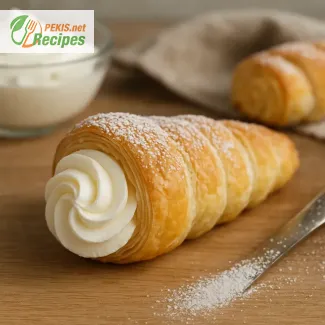Makes 8 cream horns with golden puff pastry and light whipped cream filling. Prep time 30 minutes, cook time 20 minutes, ready in 50 minutes. The balance of crisp layers and airy cream makes them perfect for both everyday treats and festive occasions. Best stored at room temperature for 2 days or frozen for up to 2 months, they can be reheated at 150 °C for 8–10 minutes before filling.
PEKIS – professional chef and recipe developer with more than 25 years of experience in cooking and baking, specialized in European and international cuisine. For cream horns, I’ve worked extensively with puff pastry techniques in both traditional bakeries and modern kitchens, refining the balance between crisp layers and smooth fillings to achieve consistently elegant results.

Decadent cream horn pastry with layers of flaky texture
A timeless European dessert with rich history
Golden spirals of puff pastry filled with smooth, sweet whipped cream create one of the most recognizable desserts across Europe – the cream horn. Each bite combines a crisp, buttery crunch with a luscious, airy filling, offering the perfect balance of texture and flavor. These pastries are elegant enough for festive occasions yet simple enough to enjoy as a comforting treat with coffee or tea.
The origins of the cream horn trace back to Central Europe, where variations known as Schaumrolle in Austria and Šamrola in Slovenia became bakery classics. Traditionally, the pastry dough is wrapped around metal cones and baked until puffed and golden. Once cooled, they are generously filled with whipped cream, custard, or other flavored creams. This dessert became especially popular in 19th-century Viennese cafés, symbolizing indulgence and refined taste, and quickly spread across neighboring regions. Today, cream horns are enjoyed worldwide, often adapted with modern fillings and creative twists.
Flavor and texture profile of cream horns
- Puff pastry delivers a crisp, delicate crunch with buttery layers.
- Whipped cream provides a light, cloud-like sweetness that balances the pastry’s richness.
- Sugar adds a sparkling coating, enhancing visual appeal and sweetness.
- Custard or flavored creams can be used for depth and variation.
Why you will love this recipe
- Irresistible combination of crisp pastry and creamy filling.
- Elegant appearance suitable for celebrations and special gatherings.
- Flexible choice of fillings – from classic whipped cream to custards and fruit mousses.
- Easy to prepare in advance and assemble before serving.
- Universally loved dessert with a nostalgic charm.
Storage and make-ahead tips
- At room temperature: up to 2 days (best stored in an airtight container).
- Refrigerated: up to 3 days if already filled.
- Freezing: unfilled pastry shells can be frozen for up to 2 months.
- Reheating: bake at 150 °C (300 °F) for 8–10 minutes to restore crispness before filling.
Creative variations to try
- Chocolate-dipped edges: dip the tips of the horns into melted dark or milk chocolate for a glossy finish.
- Berry filling: fold crushed raspberries or strawberries into whipped cream for a fruity twist.
- Nut praline cream: incorporate hazelnut or almond praline paste for a rich, nutty flavor.
- Coffee cream: add espresso to the filling for an elegant café-style dessert.
- Festive decoration: dust with powdered sugar or edible glitter for holidays and celebrations.
Cultural significance and serving ideas
The cream horn remains a staple in bakeries from Vienna to Warsaw, often sold in paper sleeves to protect their delicate shape. In modern settings, they are served at weddings, family gatherings, or as part of dessert buffets. They pair beautifully with espresso, hot chocolate, or even dessert wines. Their versatility makes them equally suitable for formal occasions or casual family treats.
Key elements that define cream horns
- Crisp, golden layers of puff pastry.
- Generous swirl of light whipped cream or custard.
- A dessert that embodies both tradition and modern creativity.
Serving inspiration with culinary entities
- Perfect addition to afternoon tea menus alongside éclairs and mille-feuille.
- A highlight in European patisserie culture where layered pastries dominate.
- Complements seasonal fruits like strawberries, raspberries, or peaches.
Creative variations
- Mini cream horns served as bite-sized party desserts.
- Savory versions filled with herbed cream cheese for appetizer platters.
- Color-themed fillings (matcha, blueberry, lemon curd) for seasonal celebrations.
- Layered dessert boards combining cream horns with tarts, profiteroles, and macarons.
This introduction ensures the cream horn stands out not only as a nostalgic classic but also as a versatile pastry adaptable to modern tastes and diverse culinary traditions.
- Preheat the oven to 200 °C (390 °F). Lightly grease metal horn molds or line them with parchment paper.
- Roll out the puff pastry into a thin sheet on a floured surface. Cut into even strips about 2–3 cm wide.
- Wrap each strip of pastry around a horn mold, starting at the tip and overlapping slightly to avoid gaps.
- Brush the wrapped pastry with beaten egg to give a golden finish when baked.
- Place the molds on a baking tray lined with parchment paper and bake for 18–20 minutes until puffed and golden.
- Remove from the oven and let cool completely before gently sliding the pastry shells off the molds.
- Whip the cream with sugar and vanilla extract until stiff peaks form.
- Fill a piping bag fitted with a star nozzle and carefully pipe the whipped cream into the cooled pastry horns.
- Dust with powdered sugar (for dusting) before serving.
FAQ questionWhat pastry works best for cream horns?
Use all-butter puff pastry for the cleanest rise and flavor. The high butter content creates distinct layers that shatter crisply after baking. If you’re laminating dough yourself, aim for thin, even layers and keep the dough cold at every step to prevent butter smearing, which can collapse the lift.
FAQ questionHow do I keep the shells crisp after filling?
Bake thoroughly at 200 °C (390 °F) until deep golden—underbaked shells go soft quickly. Let them cool completely before filling; any residual steam becomes condensation and softens layers. Pipe filling right before serving or line the interior with a thin chocolate shell to create a moisture barrier.
FAQ questionWhat’s the best way to stabilize whipped cream for the filling?
Whip chilled cream to soft peaks, add fine sugar and vanilla, then finish to stiff peaks—but stop before it turns grainy. For staying power, fold in mascarpone, a spoon of instant vanilla pudding mix, or gelatin bloom (lightly warmed). These options keep the cream light yet hold shape for hours.
FAQ questionCan I make cream horns without metal molds?
Yes. Wrap pastry strips around sturdy parchment cones or foil cones formed around a wooden spoon handle. Ensure the overlap is consistent and place seam-side down. Brush with egg wash for color, sprinkle a touch of sugar for crunch, and bake on a chilled sheet to help the shape set quickly.
FAQ questionHow do I prevent gaps or unraveling during baking?
Cut even-width strips (about 2–3 cm) and overlap each turn by 3–4 mm. Avoid stretching the dough as you wrap; stretching shrinks in the oven and opens gaps. A light egg wash acts like glue at the seam, and starting to wrap from the tip of the cone gives more control.
FAQ questionWhat fillings besides whipped cream work well?
Try pastry cream, diplomat cream (pastry cream + whipped cream), lemon curd, chocolate ganache, or coffee mousse. For lighter options, fold pureed berries into whipped cream; for richer ones, add praline paste or hazelnut spread. Aim for pipeable viscosity so it holds a clean swirl.
FAQ questionHow far in advance can I prep and how should I store them?
Bake shells up to 2 days ahead and keep unfilled in an airtight container at room temperature with a paper towel to absorb humidity. Filled horns keep 1–2 days refrigerated, but are best day-of. For longer storage, freeze unfilled shells up to 2 months and recrisp at 150 °C for 8–10 min before cooling and filling.
Cream horns remain a perfect example of how simple ingredients can be transformed into something elegant. The combination of buttery puff pastry and light whipped cream creates a pastry that is both delicate and indulgent, offering balance in every bite. Their timeless appeal makes them suitable for casual moments with coffee or as part of a festive dessert table.
The beauty of this pastry lies in its versatility. With the same crisp shell, you can explore countless fillings, from classic vanilla cream to fruit-based mousses or even nut praline. This adaptability allows cream horns to fit seamlessly into different seasons, celebrations, and personal tastes while maintaining their characteristic charm.
Beyond their taste, cream horns carry a sense of heritage. They are found in patisseries across Europe, each culture giving its own subtle twist. Whether enjoyed in a Viennese café, a family gathering, or a modern bakery, they continue to symbolize craftsmanship and attention to detail in baking.
With proper storage, these pastries can be prepared ahead, making them practical for busy schedules without sacrificing freshness. Their ability to stay crisp and delicious even after freezing ensures they remain an excellent choice for both home bakers and professionals.
Ultimately, cream horns embody the balance of tradition and creativity, standing as a pastry that connects past and present while leaving room for personal interpretation.
Allergens present in the recipe:
- Gluten (from puff pastry)
- Dairy (from whipping cream, milk butter in puff pastry)
- Egg (for brushing and possibly in pastry dough)
Suggestions for allergen-free alternatives:
- Use gluten-free puff pastry to avoid gluten.
- Replace whipping cream with coconut cream or soy-based whipping alternatives.
- Use plant-based milk wash instead of egg for brushing.
- Vitamin A: 380 µg – supports vision and immune system
- Vitamin D: 0.6 µg – important for bone health
- Calcium: 75 mg – strengthens bones and teeth
- Iron: 1.2 mg – supports oxygen transport in the blood
- Magnesium: 16 mg – contributes to muscle and nerve function
- Potassium: 110 mg – helps regulate fluid balance and blood pressure
- Vitamin E: 0.9 mg – protects cells from oxidative stress
- Selenium: 4 µg – supports antioxidant defense systems
- Polyphenols (from vanilla and pastry flour): small amounts beneficial for reducing inflammation





